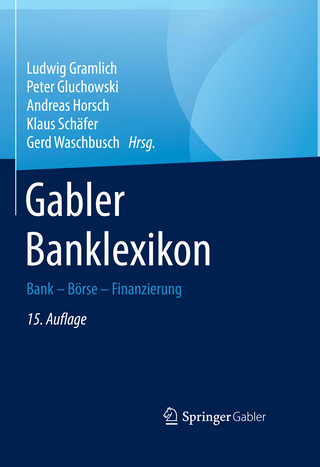
Market Risk Analysis, Practical Financial Econometrics
John Wiley & Sons Inc
978-0-470-99801-4 (ISBN)
All together, the Market Risk Analysis four volume set illustrates virtually every concept or formula with a practical, numerical example or a longer, empirical case study. Across all four volumes there are approximately 300 numerical and empirical examples, 400 graphs and figures and 30 case studies many of which are contained in interactive Excel spreadsheets available from the the accompanying CD-ROM. Empirical examples and case studies specific to this volume include:
Factor analysis with orthogonal regressions and using principal component factors;
Estimation of symmetric and asymmetric, normal and Student t GARCH and E-GARCH parameters;
Normal, Student t, Gumbel, Clayton, normal mixture copula densities, and simulations from these copulas with application to VaR and portfolio optimization;
Principal component analysis of yield curves with applications to portfolio immunization and asset/liability management;
Simulation of normal mixture and Markov switching GARCH returns;
Cointegration based index tracking and pairs trading, with error correction and impulse response modelling;
Markov switching regression models (Eviews code);
GARCH term structure forecasting with volatility targeting;
Non-linear quantile regressions with applications to hedging.
Carol Alexander is a Professor of Risk Management at the ICMA Centre, University of Reading, and Chair of the Academic Advisory Council of the Professional Risk Manager’s International Association (PRMIA). She is the author of Market Models: A Guide to Financial Data Analysis(John Wiley & Sons Ltd, 2001) and has been editor and contributor of a very large number of books in finance and mathematics, including the multi-volume Professional Risk Manager's Handbook(McGraw-Hill, 2008 and PRMIA Publications). Carol has published nearly 100 academic journal articles, book chapters and books, the majority of which focus on financial risk management and mathematical finance. Professor Alexander is one of the world's leading authorities on market risk analysis. For further details, see www.icmacentre.rdg.ac.uk/alexander.
List of Figures xiii
List of Tables xvii
List of Examples xx
Foreword xxii
Preface to Volume II xxvi
II. 1 Factor Models 1
II.1. 1 Introduction 1
II.1. 2 Single Factor Models 2
II.1.2. 1 Single Index Model 2
II.1.2. 2 Estimating Portfolio Characteristics using OLS 4
II.1.2. 3 Estimating Portfolio Risk using EWMA 6
II.1.2. 4 Relationship between Beta, Correlation and Relative Volatility 8
II.1.2. 5 Risk Decomposition in a Single Factor Model 10
II.1. 3 Multi-Factor Models 11
II.1.3. 1 Multi-factor Models of Asset or Portfolio Returns 11
II.1.3. 2 Style Attribution Analysis 13
II.1.3. 3 General Formulation of Multi-factor Model 16
II.1.3. 4 Multi-factor Models of International Portfolios 18
II.1. 4 Case Study: Estimation of Fundamental Factor Models 21
II.1.4. 1 Estimating Systematic Risk for a Portfolio of US Stocks 22
II.1.4. 2 Multicollinearity: A Problem with Fundamental Factor Models 23
II.1.4. 3 Estimating Fundamental Factor Models by Orthogonal Regression 25
II.1. 5 Analysis of Barra Model 27
II.1.5. 1 Risk Indices, Descriptors and Fundamental Betas 28
II.1.5. 2 Model Specification and Risk Decomposition 30
II.1. 6 Tracking Error and Active Risk 31
II.1.6. 1 Ex Post versus Ex Ante Measurement of Risk and Return 32
II.1.6. 2 Definition of Active Returns 32
II.1.6. 3 Definition of Active Weights 33
II.1.6. 4 Ex Post Tracking Error 33
II.1.6. 5 Ex Post Mean-Adjusted Tracking Error 36
II.1.6. 6 Ex Ante Tracking Error 39
II.1.6. 7 Ex Ante Mean-Adjusted Tracking Error 40
II.1.6. 8 Clarification of the Definition of Active Risk 42
II.1. 7 Summary and Conclusions 44
II. 2 Principal Component Analysis 47
II.2. 1 Introduction 47
II.2. 2 Review of Principal Component Analysis 48
II.2.2. 1 Definition of Principal Components 49
II 2 Principal Component Representation 49
II.2.2. 3 Frequently Asked Questions 50
II.2. 3 Case Study: PCA of UK Government Yield Curves 53
II.2.3. 1 Properties of UK Interest Rates 53
II.2.3. 2 Volatility and Correlation of UK Spot Rates 55
II.2.3. 3 PCA on UK Spot Rates Correlation Matrix 56
II.2.3. 4 Principal Component Representation 58
II.2.3. 5 PCA on UK Short Spot Rates Covariance Matrix 60
II.2. 4 Term Structure Factor Models 61
II.2.4. 1 Interest Rate Sensitive Portfolios 62
II.2.4. 2 Factor Models for Currency Forward Positions 66
II.2.4. 3 Factor Models for Commodity Futures Portfolios 70
II.2.4. 4 Application to Portfolio Immunization 71
II.2.4. 5 Application to Asset–Liability Management 72
II.2.4. 6 Application to Portfolio Risk Measurement 73
II.2.4. 7 Multiple Curve Factor Models 76
II.2. 5 Equity PCA Factor Models 80
II.2.5. 1 Model Structure 80
II.2.5. 2 Specific Risks and Dimension Reduction 81
II.2.5. 3 Case Study: PCA Factor Model for DJIA Portfolios 82
II.2. 6 Summary and Conclusions 86
II. 3 Classical Models of Volatility and Correlation 89
II.3. 1 Introduction 89
II.3. 2 Variance and Volatility 90
II.3.2. 1 Volatility and the Square-Root-of-Time Rule 90
II.3.3. 2 Constant Volatility Assumption 92
II.3.2. 3 Volatility when Returns are Autocorrelated 92
II.3.2. 4 Remarks about Volatility 93
II.3. 3 Covariance and Correlation 94
II.3.3. 1 Definition of Covariance and Correlation 94
II.3.3. 2 Correlation Pitfalls 95
II 3 Covariance Matrices 96
II.3.3. 4 Scaling Covariance Matrices 97
II.3. 4 Equally Weighted Averages 98
II.3.4. 1 Unconditional Variance and Volatility 99
II.3.4. 2 Unconditional Covariance and Correlation 102
II.3.4. 3 Forecasting with Equally Weighted Averages 103
II.3. 5 Precision of Equally Weighted Estimates 104
II.3.5. 1 Confidence Intervals for Variance and Volatility 104
II.3.5. 2 Standard Error of Variance Estimator 106
II.3.5. 3 Standard Error of Volatility Estimator 107
II.3.5. 4 Standard Error of Correlation Estimator 109
II.3. 6 Case Study: Volatility and Correlation of US Treasuries 109
II.3.6. 1 Choosing the Data 110
II.3.6. 2 Our Data 111
II.3.6. 3 Effect of Sample Period 112
II.3.6. 4 How to Calculate Changes in Interest Rates 113
II.3. 7 Equally Weighted Moving Averages 115
II.3.7. 1 Effect of Volatility Clusters 115
II.3.7. 2 Pitfalls of the Equally Weighted Moving Average Method 117
II.3.7. 3 Three Ways to Forecast Long Term Volatility 118
II.3. 8 Exponentially Weighted Moving Averages 120
II.3.8. 1 Statistical Methodology 120
II.3.8. 2 Interpretation of Lambda 121
II.3.8. 3 Properties of EWMA Estimators 122
II.3.8. 4 Forecasting with EWMA 123
II.3.8. 5 Standard Errors for EWMA Forecasts 124
II.3.8. 6 RiskMetrics TM Methodology 126
II.3.8. 7 Orthogonal EWMA versus RiskMetrics EWMA 128
II.3. 9 Summary and Conclusions 129
II. 4 Introduction to GARCH Models 131
II.4. 1 Introduction 131
II.4. 2 The Symmetric Normal GARCH Model 135
II.4.2. 1 Model Specification 135
II.4.2. 2 Parameter Estimation 137
II.4.2. 3 Volatility Estimates 141
II.4.2. 4 GARCH Volatility Forecasts 142
II.4.2. 5 Imposing Long Term Volatility 144
II.4.2. 6 Comparison of GARCH and EWMA Volatility Models 147
II.4. 3 Asymmetric GARCH Models 147
II.4.3. 1 A-garch 148
II.4.3. 2 Gjr-garch 150
II.4.3. 3 Exponential GARCH 151
II.4.3. 4 Analytic E-GARCH Volatility Term Structure Forecasts 154
II.4.3. 5 Volatility Feedback 156
II.4. 4 Non-Normal GARCH Models 157
II.4.4. 1 Student t GARCH Models 157
II.4.4. 2 Case Study: Comparison of GARCH Models for the Ftse 100 159
II.4.4. 3 Normal Mixture GARCH Models 161
II 4 Markov Switching GARCH 163
II.4. 5 GARCH Covariance Matrices 164
II.4.5. 1 Estimation of Multivariate GARCH Models 165
II.4.5. 2 Constant and Dynamic Conditional Correlation GARCH 166
II.4.5. 3 Factor GARCH 169
II.4. 6 Orthogonal GARCH 171
II.4.6. 1 Model Specification 171
II.4.6. 2 Case Study: A Comparison of RiskMetrics and O-GARCH 173
II.4.6. 3 Splicing Methods for Constructing Large Covariance Matrices 179
II.4. 7 Monte Carlo Simulation with GARCH Models 180
II.4.7. 1 Simulation with Volatility Clustering 180
II.4.7. 2 Simulation with Volatility Clustering Regimes 183
II.4.7. 3 Simulation with Correlation Clustering 185
II.4. 8 Applications of GARCH Models 188
II.4.8. 1 Option Pricing with GARCH Diffusions 188
II.4.8. 2 Pricing Path-Dependent European Options 189
II.4.8. 3 Value-at-Risk Measurement 192
II.4.8. 4 Estimation of Time Varying Sensitivities 193
II.4.8. 5 Portfolio Optimization 195
II.4. 9 Summary and Conclusions 197
II. 5 Time Series Models and Cointegration 201
II.5. 1 Introduction 201
II.5. 2 Stationary Processes 202
II.5.2. 1 Time Series Models 203
II.5.2. 2 Inversion and the Lag Operator 206
II.5.2. 3 Response to Shocks 206
II.5.2. 4 Estimation 208
II.5.2. 5 Prediction 210
II.5.2. 6 Multivariate Models for Stationary Processes 211
II.5. 3 Stochastic Trends 212
II.5.3. 1 Random Walks and Efficient Markets 212
II.5.3. 2 Integrated Processes and Stochastic Trends 213
II.5.3. 3 Deterministic Trends 214
II.5.3. 4 Unit Root Tests 215
II.5.3. 5 Unit Roots in Asset Prices 218
II.5.3. 6 Unit Roots in Interest Rates, Credit Spreads and Implied Volatility 220
II.5.3. 7 Reconciliation of Time Series and Continuous Time Models 223
II.5.3. 8 Unit Roots in Commodity Prices 224
II.5. 4 Long Term Equilibrium 225
II.5.4. 1 Cointegration and Correlation Compared 225
II.5.4. 2 Common Stochastic Trends 227
II.5.4. 3 Formal Definition of Cointegration 228
II.5.4. 4 Evidence of Cointegration in Financial Markets 229
II.5.4. 5 Estimation and Testing in Cointegrated Systems 231
II.5.4. 6 Application to Benchmark Tracking 239
II.5.4. 7 Case Study: Cointegration Index Tracking in the Dow Jones Index 240
II.5.5 Modelling Short Term Dynamics 243
II.5.5.1 Error Correction Models 243
II.5.5. 2 Granger Causality 246
II.5.5. 3 Case Study: Pairs Trading Volatility Index Futures 247
II.5. 6 Summary and Conclusions 250
II. 6 Introduction to Copulas 253
II.6. 1 Introduction 253
II.6. 2 Concordance Metrics 255
II.6.2. 1 Concordance 255
II.6.2. 2 Rank Correlations 256
II.6. 3 Copulas and Associated Theoretical Concepts 258
II.6.3. 1 Simulation of a Single Random Variable 258
II.6.3. 2 Definition of a Copula 259
II.6.3. 3 Conditional Copula Distributions and their Quantile Curves 263
II.6.3. 4 Tail Dependence 264
II.6.3. 5 Bounds for Dependence 265
II.6. 4 Examples of Copulas 266
II.6.4. 1 Normal or Gaussian Copulas 266
II.6.4. 2 Student t Copulas 268
II.6.4. 3 Normal Mixture Copulas 269
II.6.4. 4 Archimedean Copulas 271
II.6. 5 Conditional Copula Distributions and Quantile Curves 273
II.6.5. 1 Normal or Gaussian Copulas 273
II.6.5. 2 Student t Copulas 274
II.6.5. 3 Normal Mixture Copulas 275
II.6.5. 4 Archimedean Copulas 275
II.6.5. 5 Examples 276
II.6. 6 Calibrating Copulas 279
II.6.6. 1 Correspondence between Copulas and Rank Correlations 280
II.6.6. 2 Maximum Likelihood Estimation 281
II.6.6. 3 How to Choose the Best Copula 283
II.6. 7 Simulation with Copulas 285
II.6.7. 1 Using Conditional Copulas for Simulation 285
II.6.7. 2 Simulation from Elliptical Copulas 286
II.6.7. 3 Simulation with Normal and Student t Copulas 287
II.6.7. 4 Simulation from Archimedean Copulas 290
II.6. 8 Market Risk Applications 290
II.6.8. 1 Value-at-Risk Estimation 291
II.6.8. 2 Aggregation and Portfolio Diversification 292
II.6.8. 3 Using Copulas for Portfolio Optimization 295
II.6. 9 Summary and Conclusions 298
II. 7 Advanced Econometric Models 301
II.7. 1 Introduction 301
II.7. 2 Quantile Regression 303
II.7.2. 1 Review of Standard Regression 304
II.7.2. 2 What is Quantile Regression? 305
II.7.2. 3 Parameter Estimation in Quantile Regression 305
II.7.2. 4 Inference in Linear Quantile Regression 307
II.7.2. 5 Using Copulas for Non-linear Quantile Regression 307
II.7. 3 Case Studies on Quantile Regression 309
II.7.3. 1 Case Study 1: Quantile Regression of Vftse on FTSE 100 Index 309
II.7.3. 2 Case Study 2: Hedging with Copula Quantile Regression 314
II.7. 4 Other Non-Linear Regression Models 319
II.7.4. 1 Non-linear Least Squares 319
II.7.4. 2 Discrete Choice Models 321
II.7. 5 Markov Switching Models 325
II.7.5. 1 Testing for Structural Breaks 325
II.7.5. 2 Model Specification 327
II.7.5. 3 Financial Applications and Software 329
II.7. 6 Modelling Ultra High Frequency Data 330
II.7.6. 1 Data Sources and Filtering 330
II.7.6. 2 Modelling the Time between Trades 332
II.7.6. 3 Forecasting Volatility 334
II.7. 7 Summary and Conclusions 337
II. 8 Forecasting and Model Evaluation 341
II.8. 1 Introduction 341
II.8. 2 Returns Models 342
II.8.2. 1 Goodness of Fit 343
II.8.2. 2 Forecasting 347
II.8.2. 3 Simulating Critical Values for Test Statistics 348
II.8.2. 4 Specification Tests for Regime Switching Models 350
II.8. 3 Volatility Models 350
II.8.3. 1 Goodness of Fit of GARCH Models 351
II.8.3. 2 Forecasting with GARCH Volatility Models 352
II.8.3. 3 Moving Average Models 354
II.8. 4 Forecasting the Tails of a Distribution 356
II.8.4. 1 Confidence Intervals for Quantiles 356
II.8.4. 2 Coverage Tests 357
II.8.4. 3 Application of Coverage Tests to GARCH Models 360
II.8.4. 4 Forecasting Conditional Correlations 361
II.8. 5 Operational Evaluation 363
II.8.5. 1 General Backtesting Algorithm 363
II.8.5. 2 Alpha Models 365
II.8.5. 3 Portfolio Optimization 366
II.8.5. 4 Hedging with Futures 366
II.8.5. 5 Value-at-Risk Measurement 367
II.8.5. 6 Trading Implied Volatility 370
II.8.5. 7 Trading Realized Volatility 372
II.8.5. 8 Pricing and Hedging Options 373
II.8. 6 Summary and Conclusions 375
References 377
Index 387
| Erscheint lt. Verlag | 1.6.2008 |
|---|---|
| Reihe/Serie | Wiley Finance Series |
| Verlagsort | New York |
| Sprache | englisch |
| Maße | 175 x 249 mm |
| Gewicht | 907 g |
| Themenwelt | Wirtschaft ► Betriebswirtschaft / Management ► Finanzierung |
| ISBN-10 | 0-470-99801-6 / 0470998016 |
| ISBN-13 | 978-0-470-99801-4 / 9780470998014 |
| Zustand | Neuware |
| Haben Sie eine Frage zum Produkt? |
aus dem Bereich


